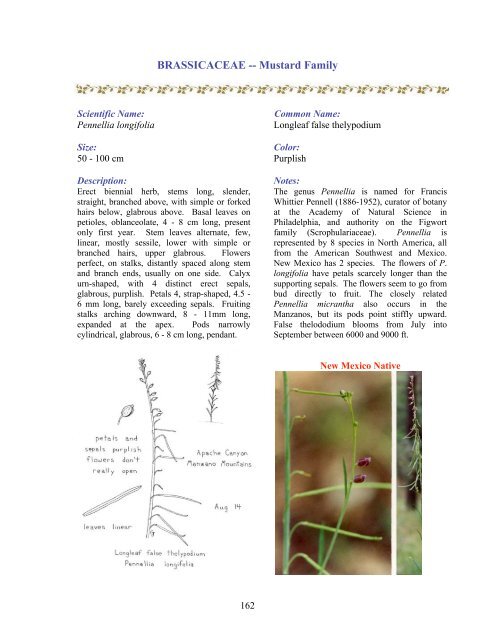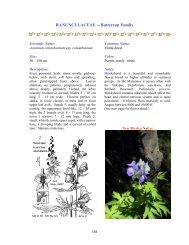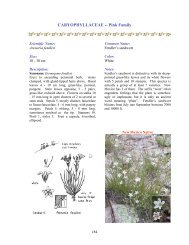BERBERIDACEAE -- Barberry Family - New Mexico Flores
BERBERIDACEAE -- Barberry Family - New Mexico Flores
BERBERIDACEAE -- Barberry Family - New Mexico Flores
You also want an ePaper? Increase the reach of your titles
YUMPU automatically turns print PDFs into web optimized ePapers that Google loves.
Scientific Name:<br />
Pennellia longifolia<br />
Size:<br />
50 - 100 cm<br />
BRASSICACEAE -- Mustard <strong>Family</strong><br />
Description:<br />
Erect biennial herb, stems long, slender,<br />
straight, branched above, with simple or forked<br />
hairs below, glabrous above. Basal leaves on<br />
petioles, oblanceolate, 4 - 8 cm long, present<br />
only first year. Stem leaves alternate, few,<br />
linear, mostly sessile, lower with simple or<br />
branched hairs, upper glabrous. Flowers<br />
perfect, on stalks, distantly spaced along stem<br />
and branch ends, usually on one side. Calyx<br />
urn-shaped, with 4 distinct erect sepals,<br />
glabrous, purplish. Petals 4, strap-shaped, 4.5 -<br />
6 mm long, barely exceeding sepals. Fruiting<br />
stalks arching downward, 8 - 11mm long,<br />
expanded at the apex. Pods narrowly<br />
cylindrical, glabrous, 6 - 8 cm long, pendant.<br />
162<br />
Common Name:<br />
Longleaf false thelypodium<br />
Color:<br />
Purplish<br />
Notes:<br />
The genus Pennellia is named for Francis<br />
Whittier Pennell (1886-1952), curator of botany<br />
at the Academy of Natural Science in<br />
Philadelphia, and authority on the Figwort<br />
family (Scrophulariaceae). Pennellia is<br />
represented by 8 species in North America, all<br />
from the American Southwest and <strong>Mexico</strong>.<br />
<strong>New</strong> <strong>Mexico</strong> has 2 species. The flowers of P.<br />
longifolia have petals scarcely longer than the<br />
supporting sepals. The flowers seem to go from<br />
bud directly to fruit. The closely related<br />
Pennellia micrantha also occurs in the<br />
Manzanos, but its pods point stiffly upward.<br />
False thelododium blooms from July into<br />
September between 6000 and 9000 ft.<br />
<strong>New</strong> <strong>Mexico</strong> Native




